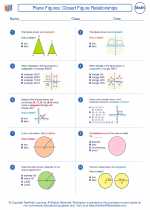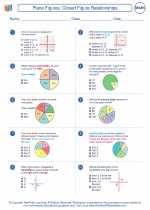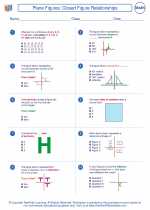Line Symmetry
Line symmetry, also known as reflection symmetry, is a concept in geometry where an object can be divided into two halves, such that one half is the mirror image of the other when folded along a line. This line is called the line of symmetry, and objects that have this property are said to be symmetrical.
Understanding Line Symmetry
To understand line symmetry, it's important to know the following key points:
- Line of Symmetry: This is the line along which an object can be folded so that the two halves match exactly. For example, the letter "A" has a line of symmetry running vertically down the middle.
- Symmetrical Objects: Objects that have line symmetry include geometric shapes like squares, rectangles, circles, and regular polygons, as well as letters of the alphabet and various real-life objects.
- Number of Lines of Symmetry: Some objects have multiple lines of symmetry, while others have none. For instance, a square has four lines of symmetry, while a scalene triangle has none.
Testing for Line Symmetry
To determine if an object has line symmetry, you can follow these steps:
- Draw the Line of Symmetry: Identify a potential line of symmetry and draw it on the object.
- Check for Reflection: See if one half of the object is the mirror image of the other when folded along the line of symmetry.
- Verify Symmetry: If the two halves match exactly, the object has line symmetry along that line. If not, try another potential line of symmetry.
Properties of Line Symmetry
Some important properties of line symmetry include:
- Reflexivity: Every object is symmetrical with respect to itself. This means that the line of symmetry can pass through the object in such a way that the two halves coincide.
- Transitivity: If object A is symmetrical with object B, and object B is symmetrical with object C, then object A is symmetrical with object C.
Study Guide for Line Symmetry
When studying line symmetry, it's helpful to practice identifying lines of symmetry in various objects. You can also do the following exercises:
- Draw different shapes and test for line symmetry.
- Identify objects in your surroundings that have line symmetry.
- Try to create your own symmetrical designs and patterns.
Understanding line symmetry is important not only in geometry, but also in art, design, and various real-world applications. It helps us recognize and appreciate the balance and harmony in shapes and forms around us.
Now that you have a good understanding of line symmetry, feel free to explore further and practice more to strengthen your understanding of this concept!
.◂Math Worksheets and Study Guides Seventh Grade. Plane Figures: Closed Figure Relationships

 Worksheet/Answer key
Worksheet/Answer key
 Worksheet/Answer key
Worksheet/Answer key
 Worksheet/Answer key
Worksheet/Answer key
